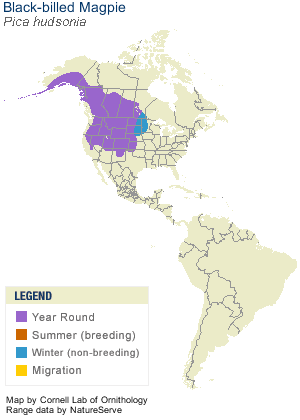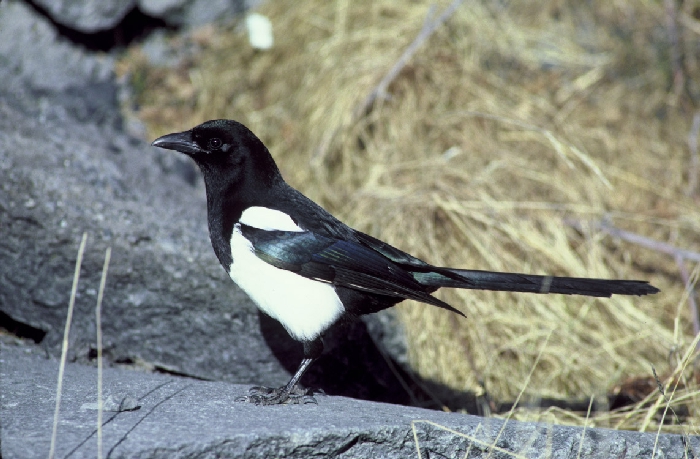|
Cool
Facts
- Until
very recently the Black-billed Magpie was considered the same
species as the Eurasian Magpie. Vocal and behavioral differences
suggest that the American magpie with the black bill is more closely
related to the Yellow-billed Magpie than to the European black-billed
magpie. The Eurasian Magpie is found across a vast range from
northern Africa across Europe to Southeast Asia and Siberia. It
may in fact be several different species.
- The
Black-billed Magpie makes a very large nest that can take up to
40 days to construct. It's a lot of work, but a study found that
it only used about 1% of the daily energy expenditure of the pair.
Laying eggs, on the other hand, takes 23% of the female's daily
energy budget.
- Like
most members of its family, the Black-billed Magpie is known as
a predator on nests of other birds. Although it will take eggs
and nestlings, these items actually make up only a tiny portion
of the magpie's diet. In England, one study found that songbird
density actually increased when Eurasian Magpie density increased.
- The
Black-billed Magpie frequently lands on large mammals, such as
deer and moose, to remove ticks from them. The magpie eats the
ticks, and then hides some for later use, as members of the crow
and jay family often do with excess food. Most of the ticks, however,
are cached alive and unharmed, and may live to reproduce later.
|
Measurements
(Both Sexes)
|
Length
|
Wingspan
|
Weight
|
Other
Names
|
|
|
17.7–23.6
in
|
22–24
in
|
5.1–7.4
oz
|
Pie
d'Amérique (French)
|
|
|
45–60
cm
|
56–61
cm
|
145–210
g
|
|
 Habitat Habitat
Black-billed
Magpies are found in open country, but need large shrubs or trees
for nesting. They are especially suited to areas with cottonwood
or willows, streams, farmland, wetlands, and orchards. During winter,
they roost in streamside groves of trees or lowland conifers, although
they avoid unbroken forests.
Behavior
Black-billed
Magpies are intelligent and resourceful opportunists. They form
large, noisy roosts in winter, sometimes numbering over 700 birds.
They flip items over to look for food, follow predators, and sometimes
steal food from other birds. They also take ticks from the backs
of large mammals, and pick at open sores on those animals' bodies.
They can even use scent to find food--an unusual trait for birds,
which generally have very little sense of smell. They are often
very bold, but in areas where they have been harassed, they become
quite wary.
Diet
Black-billed
Magpies are omnivores but feed most often on insects. During post-breeding
dispersal, they eat a number of conifer seeds. They eat berries,
nuts, and seeds during winter. Black-billed Magpies also eat carrion.
Nesting
Black-billed
Magpies are monogamous and form long-term pair bonds. Pairs first
form in the fall or winter within wintering flocks. They often nest
in small, loose colonies, but this may be more a factor of the distribution
of trees for nesting rather than true colonialism. Both sexes help
build a huge nest in the branches of a deciduous tree. The nest
is used in succeeding years by many other species, e.g., owls. The
nest itself is enveloped in a large (up to three feet in diameter),
dome-shaped, stick canopy, with entrances on both sides. Inside
the stick canopy is a cup-shaped nest with a mud or manure base
and a lining made from weeds, rootlets, hair, and grass. The female
lays up to 9 eggs, but the typical clutch ranges from 6-7 eggs.
The male brings food while the female incubates (for about 18 days).
Both feed the young after they hatch. The young leave the nest at
3-4 weeks, and join with 2-8 other broods. The parents feed their
own fledglings in these groups for another 3-4 weeks.

Migration
Status
Black-billed
Magpies are year-round residents across their range, but occasionally
undergo post-breeding movements upslope into the Cascades and the
Blue Mountains.
Conservation
Status
Black-billed
Magpies traditionally followed Native Americans and lived off the
refuse of their bison hunts. Black-billed Magpies now frequent farms
and ranches, and have been known to rob trap-lines, take poultry
eggs, and raid orchards. They were considered vermin, and many Black-billed
Magpies were killed as pests in the early 20th Century. They are
still considered pests by some. Despite this, they remain common
and widespread. They are protected in the United States, but not
in Canada where they are still killed in some areas. Pesticides
are of concern, especially those used on livestock, since magpies
often perch on livestock and eat those pests that are being poisoned.
|




 Habitat
Habitat